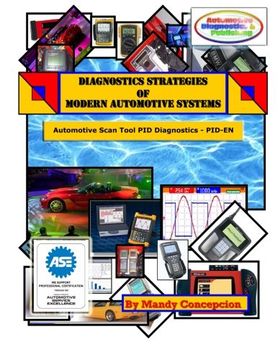Automotive Scan Tool pid Diagnostics: Diagnostic Strategies of Modern Automotive Systems: Volume 6
Synopsis "Automotive Scan Tool pid Diagnostics: Diagnostic Strategies of Modern Automotive Systems: Volume 6"
Automotive Scan Tool PID Diagnostics(Diagnostics Strategies of Modern Automotive Systems )By Mandy ConcepcionIn this section, the different techniques of scan tool parameter (PID) analysis will be exposed. Techniques involving PID analysis are quickly catching on, due to their speed and accuracy. By properly analyzing the different scanner PIDs, the technician can arrive at the source of the problem much faster and accurately. These procedures give rise to the new term "driver seat diagnostics", since most of the preliminary diagnostic work is done through the scanner. However, these techniques will in no way replace the final manual tests that are a part of every diagnostic path. They are simply geared to point the technician in the right direction.Table of ContentsINTRODUCTION (Introduction to scan tool diagnostics and therelevance of using PIDs or scanner parameter to perform the first legof all diagnostics.)- Theory of Operation Behind the Different PIDs (Describes CARB, thedifference between generic and enhanced PIDs, the FTP)- OBD II Generic PIDs (PID calculated and actual values, calculateddata relationships, base injection timing, ECM value substitution)- OBD I & II General PID analysis (erasing code-or not, recording, analyzing and pinpoint tests, separating PIDs into groups)- Fuel Delivery Fault Detection (fuel delivery issues, intake air temp.sensor, BARO sensor, Engine LOAD, RPM PID, Short-Term Fuel Trims, Long-Term Fuel Trims, 60% of check engine light issues, blocklearn/integrators, Example 1: injector fault, Example 2: intake gasketissues, fuel status, ignition timing, MAP/MAF, TPS, O2 sensor, IAC, Closed Throttle, injector pulse width, voltage power, injector dutycycle, fuel trim cell)- Test #1 (Determining an engine's fuel Consumption (rich-leanoperation, duty-cycle to fuel trim relationship, O2 sensor to fuel trimrelation, FT and vacuum leaks, ignition timing and idle control, testconclusion)- Test # 2 (Misfire Detection Strategy, EGR, Ignition and Mechanicalmisfires) (misfires and OBD2, scanner misfire detection - a time saver, OBD2 40 and 80 cycle misfire, ignition, injector and EGR densitymisfire, coil-on-plug, misfires and O2 sensor, lean O2 & Secondarymisfire, O2 sensor & injector misfires, leaky injector, EGR and theMAP, Type A, B, C misfires, test conclusion)- Test # 3 (Air/Fuel Ratio Faults) (air-fuel imbalance, MAF and post O2sensors, open-closed-loop, fuel enable, HC & CO relation to AF issues, test conclusion)- Test # 4 (BARO, MAP & MAF PID analysis) (MAP & valve timingfaults, ECM behavior, fuel delivery or duty cycle test, volumetricefficiency, test conclusion)- Test # 5 (Clogged exhaust) (clogged catalytic converter detection, TPS, MAF and converters, idle and WOT or wide open throttle values, vacuum readings, MAP to WOT chats analysis, engine and MAPvacuum, test conclusion)- Test # 6 (EGR Fault Detection) (EGR and MAP values, ECM reactionto EGR issues, EGR temp sensor, DPFE sensor, EGR and O2-MAP andlift position sensor, EGR and engine pre-loading, EGR and the ECMerroneous high LOAD issues, test conclusion)- Test # 7 (O2 Sensor Heater) (O2 heaters and why?, tough to checkO2 heater issues, O2 heater effect on signal output, O2 heater biasvoltage, engine off and O2 changing value, test conclusion)- Test # 8 (Resetting Fuel Trims) (resetting injection pulse corrections, long-term and short-term fuel trims, learn condition, Lambda, casestudy on fuel trims, FT resetting according to manufacturer, testconclusion)- Test # 9 (Engine Cranking Vacuum Test) (MAP/MAF crankingvacuum, vacuum to PID analysis, vacuum leaks, gauge-PID test, sources of leaks, cranking values, test conclusion)

